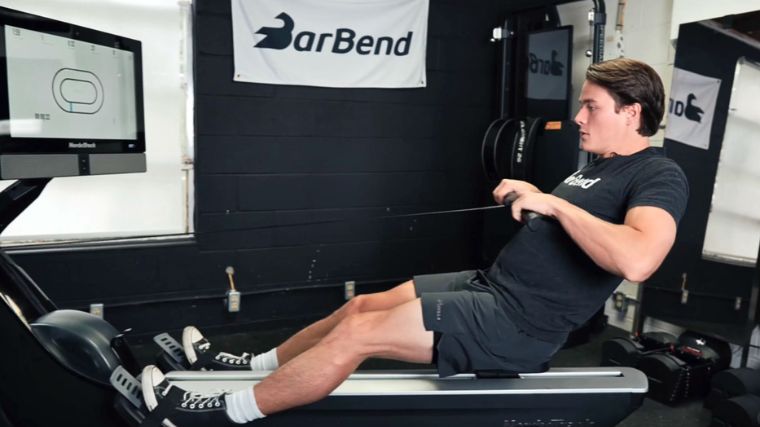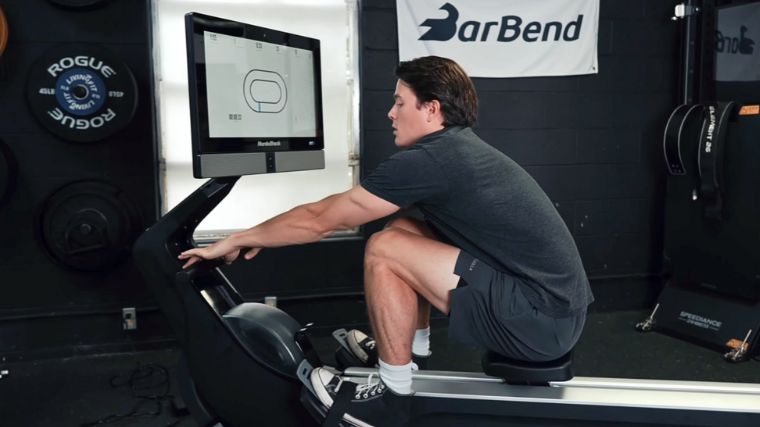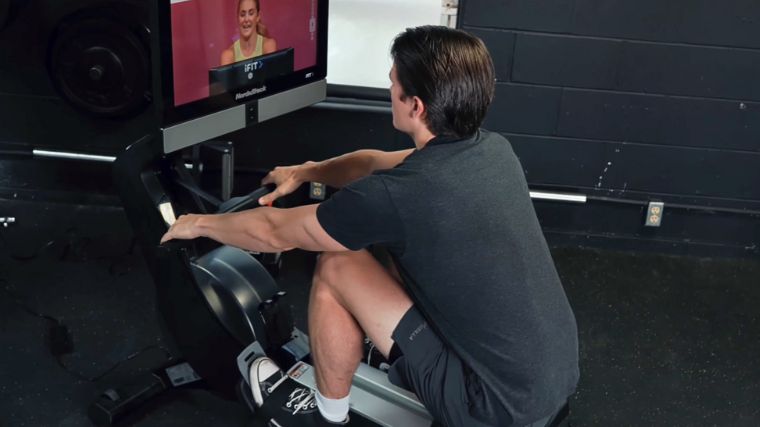People head to the gym for all sorts of reasons. Maybe you want to shake away some stress, and you know the barbell is helpful. Or maybe you’re aiming to lift heavier than you’ve ever done or build some ridiculously strong tree trunks. Still other folks work out, at least partially, when they’re wanting to lose weight.

If that’s a goal of yours, you might look longingly at the cardio floor. Before you choose which cardio machine will be your next dance partner, you might wonder: does rowing work for weight loss? I sat down with world champion rower Megan Cooke Carcagno, the head coach of the Duke University Women’s Rowing program, to get her take on the matter.
How Does Rowing Help With Weight Loss?
It’s no secret that competitive rowers tend to be in phenomenal shape, both aesthetically and in terms of their muscular efficiency. It turns out that several features of rowing make it quite adept at contributing to the processes that lead to fat-burning and weight loss.
Burns Calories
Rowing enables you to take both your upper body and lower body through long stretches of cardio, resulting in plenty of calories burned. Whether you opt for a steady-state aerobic workout or some quick high-intensity interval training (HIIT) activity, rowing can certainly aid you in creating the exact sort of calorie deficit that contributes to fat loss.
Engages More Muscles
The rowing stroke directly engages nearly all of the major muscle groups from across your body against resistance, while taking your limbs through a substantial range of motion. As a result, rowing has the potential to build muscle while involving more muscles than other cardio methods.
Easy On Joints
Rowing is a low-impact cardio exercise that is relatively gentle on your joints even during high-intensity training — just as long as you use proper rowing technique. This means that a rowing workout can get quite intense with less wear-and-tear on your body, with the number of calories burned over time potentially yielding a commensurate fat loss.
The Benefits of Rowing
Aside from weight loss, rowing has several benefits that are rather unique as far as cardio options are concerned. So even if you approach rowing for the first time with an eventual goal of fat-burning, you can expect that your hard work will produce even broader benefits. This can result in you acquiring a level of fitness that transcends mere fat loss.
Power and Strength
Rowing has you apply as much force as you can muster into each rowing stroke, with major contributions submitted by your quads, hamstrings, and glutes. In essence, the same muscles used during a squat are used explosively during the rowing stroke. This makes rowing a solid cardiovascular complement to strength training.

[Read More: Does Rowing Build Muscle? How to Get Ripped on a Rowing Machine]
“There’s a load component to rowing, whether you’re on the water or you’re using an ergometer, which is like a land-based rowing machine,” says Carcagno. “You’re picking up a flywheel or a load of the boat weight on every stroke. So there’s an initial power application that’s needed and then the carry-through, almost like doing a horizontal clean. And that’s just one stroke. So if you think about typically in rowing you’re doing anywhere between 20 to 40 strokes per minute. You can see how quickly the accumulation of watts moved over a time period could be very beneficial for strength.”
Endurance
The low-impact nature of rowing means that you can exert major force with your muscles and heart without also stressing your joints. This provides you with the option to string together long rowing workouts that train all of your energy systems while conditioning your muscles to withstand it as well.
[Read More: The Best HIIT Rowing Workout, Customized to Your Experience Level]
“Typically to hold that load, it’s going to place some pressure on your lungs and your heart, in a similar fashion to cross-country skiing or running, where you’re producing watts over and over again,” explains Carcagno. “It will leave you winded and you’ll have to work through that and the more that you do it, the better that you get at it and the more efficient that you get at it.”
You can always go a little higher or a few more strokes per minute. You can always lift more load, which ultimately is going to continue to increase your aerobic endurance.
— Megan Cooke Carcagno
Full-Body Workout
You don’t need a full complement of barbells and weight plates to get in a full-body exercise routine. All you need is a little bit of indoor rowing to reach your fitness goals.
[Read More: The Benefits of Rowing Machines for Strength Athletes (and Everyone Else)]
“It’s a full-body sport, meaning that you’re using the muscles in your feet all the way up to the muscles through your neck and through your hands,” says Carcagno. “It pretty much requires every single muscle in your body at once.”
Try These 3 Rowing Workouts for Weight Loss
Here are three rowing machine workouts straight from Carcagno, a world-champion rower and the coach of the Duke University Women’s Rowing team. All of these workouts can help you with your weight loss goals. They will also elevate your heart rate, and provide you with a full-body workout that exceeds anything you can achieve on an elliptical.
Low-Intensity Rowing Workout for Weight Loss
Don’t be fooled by the simplicity here: this is a very challenging row. But, it’s still an aaccessible entry point for many athletes, especially when you take it nice and slow. And yet, it’ll keep the advanced athletes coming back for more, too.
[Read More: The Best Water Rowing Machines on the Market]
The Workout
- 1 x 5K (5,000 meters)
How Often to Do This Workout: Beginners can try this workout once a week, while more advanced rowers can do it almost daily.
Modifications
- Make it Easier: Row at a relaxed pace throughout, and take plenty of rest when needed.
- Make it Harder: Turn it into a high-intensity interval training workout, where you row 100 meters at top speed, then 400 meters at a slow pace, and repeat this pattern throughout.
5:5 Rowing Workout for Weight Loss
You can make this workout as intense — or not intense — as you want. And what’s more, you can do it with a friend or training partner along for the ride. Because you’ll be taking a five-minute rest, you can decide to go as hard as you can during the five minutes on. But pace yourself, because five minutes lasts a lot longer on the rower than you think it will.
[Read More: Ways to Improve Your Rowing Stroke]
The Workout
- 3 x Five minutes on; Five minutes off
How Often to Do This Workout: Three times per week.
Modifications
- Make it Easier: Don’t worry about surpassing your prior efforts or that of your partner; just complete your rows at a pace that feels challenging but sustainable. If each round leaves you recording less distance, that’s OK.
- Make it Harder: Make it four minutes on, and four minutes off — this will help you row harder, but with less recovery time.
High-Intensity Rowing Workout for Weight Loss
Not all high-intensity workouts look like they’re all that difficult in the description. But it’s not all about pushing hard and fast 20-second sprints. In many cases — especially on the rower — the high intensity comes from pushing yourself as hard as you can for an uncomfortable distance.

[Read More: Indoor Rowing Workouts That Won’t Bore You To Death]
In this case, 750 meters is far enough to truly fatigue your body and mind at a high-effort pace, but short enough to make that high effort truly intense. That’s a wicked combination, and excellent for both conditioning and weight loss goals.
The Workout
- 4 x 750 meters at your 2K pace; 3-minute rest between each row
How Often to Do This Workout: Do this twice per week if you’re experienced, but twice a month or so if you’re newer to the sport.
Modifications
- Make it Easier: Make the distances shorter, doing 500 meters instead of 750.
- Make it Harder: Raise the proverbial bar to doing 1,000 meters each round.
FAQs
Still deciding if rowing should be part of your weight loss strategy? We answer some important questions for you below.
How long should I use a rowing machine for weight loss?
The low-impact nature of rowing workouts makes them a solid weight-loss tool. As such, rowing can be used as a weight-loss aid just like most other cardio machines, like ellipticals and treadmills. Building up from a few minutes of rowing to upwards of 30 minutes on the rower can all go a long way toward helping improve your conditioning and weight loss potential.
How many calories does rowing burn?
The number of calories you burn during rowing workouts depends on several factors, like your current weight, your effort level, and the duration of your workout. Based on these variables, a person with a body weight of 180 pounds may burn between 400 and 1,000 calories during a one-hour rowing session. Someone who weighs less will generally burn fewer calories at the same effort level and duration.
What are the benefits of rowing for weight loss?
Including rowing in your workout program will improve the strength and power of your muscles. The rowing stroke also places a greater number of your body’s muscles under tension than a form of cardio like running. This can help increase muscle mass and support your resistance training efforts.
Editor’s Note: The content on BarBend is meant to be informative in nature, but it should not be taken as medical advice. When starting a new training regimen and/or diet, it is always a good idea to consult with a trusted medical professional. We are not a medical resource. The opinions and articles on this site are not intended for use as diagnosis, prevention, and/or treatment of health problems. They are not substitutes for consulting a qualified medical professional.
The post Does Rowing for Weight Loss Work? A World Champion Rower Says Yes (+ Gives You Rowing Workouts) appeared first on BarBend.

